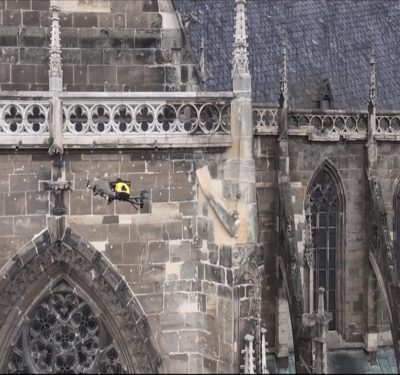
In late 2019, Wing drones began delivering packages to homes in Christiansburg, Virginia, making the town the first in the U.S. to trial such a service—and so far residents are happy with the experience.
That’s according to a recent survey conducted by the Virginia Tech Mid-Atlantic Aviation Partnership, or MAAP, an FAA-designated test site that worked with Wing to launch the program through the FAA’s Integration Pilot Program (IPP). In fact, 87% of respondents said they like the idea of drone delivery, a number much higher than what’s been seen with speculative surveys, said Lee Vinsel, an assistant professor of science, technology and society at Virginia Tech who worked with the MAAP team to create the 20-question survey. Those numbers typically hoover around 50%.
The main difference? In the past, respondents hadn’t actually received packages via drone or talked to neighbors about their experiences, Vinsel said. Instead of seeing the benefits first-hand, they previously were asked to speculate on whether they would like a new service and were presented with questions that identified potential problems from the start, such as safety and surveillance. MAAP’s survey instead asked qualitative questions about the upsides and downsides of drone delivery, without mentioning what either might be.
The MAAP team also spent months educating the community before beginning the deliveries, Director Tombo Jones said, making sure they were comfortable with the drone flights and had the chance to ask questions. That helped alleviate fear of the unknown from the beginning, and likely attributed to the positive reaction to the program.
“They understood what went into the effort to make these deliveries safe and efficient,” Jones said, “and could see and understand the advantages without having to visualize it.”
The Delivery Program
Residents in the delivery area can sign up for the program, download an app and order a variety of goods, Jones said. They can arrange for their FedEx packages to be delivered last-mile via drone, or they can order items from Walgreens. Wing recently began working with a local Girl Scouts troop to deliver cookies through the end of May, helping with a 50% shortfall in sales thanks to the COVID-19 pandemic.
Local businesses also are involved in the delivery program, including restaurants, an ice cream parlor and even the library—another factor that likely played into positive attitudes toward the program, Jones said. Deliveries are made five days a week.
When an order is placed, the aircraft lifts into a hover, the goods are packaged and are loaded onto the drone tether by an operator at the company’s operations site known as the Nest, Jones said. The drone then flies to the delivery address, the package is lowered on a tether while the drone hovers about 20 feet in the air, and the hook releases automatically when the package rests on the ground. The typical time from order to delivery is about 10 minutes.
The Positives
Respondents listed convenience and speed as two of the main benefits, Vinsel said, and they also liked the fact they didn’t have to leave the house or have contact with another person to receive their goods—both critical during the COVID-19 pandemic.
Contactless delivery became huge once COVID-19 hit last year, and about 60% of respondents indicated the pandemic gave them a more positive view on drone delivery. The program also helped businesses stay afloat, giving them another way to get food and other products to customers during challenging times.
“Worldwide, Wing saw an uptick in the number of delivery requests because of the fact it’s a noncontact way to receive goods,” Jones said. “In the early months of spring last year, we saw as much as a 300% increase in deliveries.”
Noise Biggest Concern
In speculative surveys, typically as many as 70% of respondents say drone package delivery brings up concerns surrounding surveillance and safety. Those types of worries were on the minds of less than 10% of the MAAP survey respondents, Vinsel said. The most common downside listed, noise, came in at 17%. But 75% of the respondents who brought up noise as a concern were still positive about drone delivery.
Despite any concerns, overall, 89% of respondents said they had or would use the service.
Next Steps
The FAA and industry as a whole are very interested in this data, Vinsel said, and he sees areas that are considering incorporating similar programs using the findings as talking points in the future.
While there aren’t any plans for other surveys right now, Vinsel said he would love to poll a new location where drone delivery is being implemented, and then ask the same questions a few years later to see how attitudes have changed over time.
Drone deliveries will continue in Christiansburg under the FAA’s new BEYOND program, Jones said, and will serve as a road map for others who want to add drove delivery in their communities.
“Wing’s program has helped lead the way, and we’ve worked closely with the FAA to determine what that pathway is,” he said. “Now, as Wing starts to expand operations and other providers look at the process to gain approvals, the pathway has started to be paved. This will become scalable, where a year and a half ago it wasn’t, because the processes and pathways hadn’t been determined yet.”






